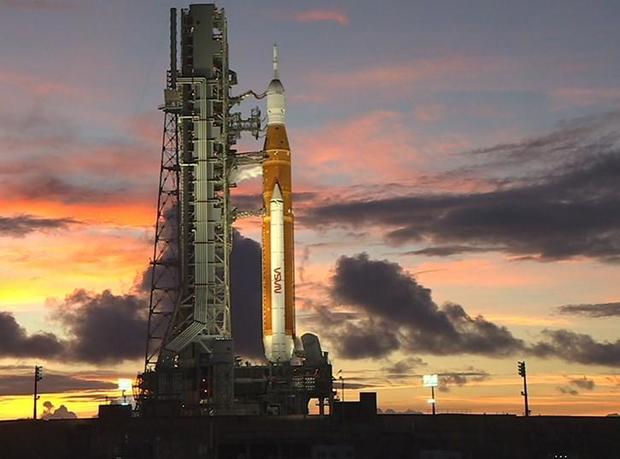After months of tests, troubleshooting and repairs, engineers fueled the Space Launch System moon rocket for blastoff Monday on NASA’s long-overdue Artemis 1 test flight — a mission to send an unpiloted Orion crew capsule on a 42-day mission beyond the moon and back. But stormy weather, an apparent hydrogen leak and trouble cooling one of the rocket’s main engines forced managers to call off the long-awaited launch attempt.
It was a frustrating disappointment for more than 25,000 NASA workers, dignitaries and other guests gathered at the Kennedy Space Center to witness the historic launching, and for thousands of area residents and tourists lining area roads and beaches.
It was equally disappointing for the hundreds of engineers and technicians who have labored for months to ready the giant moon rocket for launch. But it was not to be.
NASA was taking no chances with the $4.1 billion rocket, the most powerful ever built for NASA and the linchpin in the agency’s plans to return astronauts to the moon in the next three years.
After repeated attempts to resolve the hydrogen cooling issue were unsuccessful, Launch Director Charlie Blackwell-Thompson called off the countdown around 8:40 a.m. EDT, a few minutes after the two-hour launch window opened at 8:33 a.m.
The next launch opportunity, assuming the problems encountered Monday can be resolved in time and assuming an additional fueling test is not required, is 12:48 p.m. Friday.
Based on the constantly changing positions of the Earth and moon, only one other opportunity is available after that — September 5 at 5:12 p.m. — before the rocket would have to be hauled off the pad and back to the iconic Vehicle Assembly Building for servicing.
In that case, launch likely would slip into late September or, more likely, October. But no decisions will be made until after engineers have time to review data and determine a course forward.
The Artemis 1 test flight is intended to verify the rocket’s ability to propel Orion capsules into Earth orbit and then onto the moon. Engineers also will test the crew ship’s myriad systems in deep space and make sure its heat shield can protect returning astronauts from the 5,000-degree heat of re-entry.
NASA plans to follow the uncrewed Artemis 1 mission by launching four astronauts on a looping around-the-moon flight in 2024, setting the stage for the first astronaut landing in nearly 50 years when the first woman and the next man step onto the surface in the 2025-26 timeframe.
But first, NASA must prove the rocket and capsule will work as planned and that begins with the uncrewed Artemis 1 test flight.
The SLS rocket is the most powerful ever built by NASA, standing 322 feet tall, weighing 5.7 million pounds when loaded with propellant and generating 8.8 million pounds of thrust at liftoff, 15 percent more than NASA’s legendary Saturn 5, the current record holder.
The countdown began Saturday and proceeded smoothly until late Sunday night when offshore storms with rain and lightning moved within about six miles of launch complex 39B, violating NASA safety rules.
After a 55-minute delay, the six-hour fueling process finally got underway at 1:14 a.m. as engineers, working by remote control, began pumping 730,000 gallons of supercold liquid oxygen and hydrogen fuel into the SLS core stage, clearing the way for another 22,000 gallons to be pumped into the upper stage.
During a transition from “slow fill” to a 10 times faster rate, sensors detected higher-than-allowable concentrations of hydrogen in a housing around an umbilical that delivers propellants to the base of the core stage, indicating a leak somewhere in the system.
After reverting back to slow fill and allowing temperatures to equalize across the plumbing, fast fill was restarted and this time around, there were no issues.
Then another issue developed. When the hydrogen tank was full, propellants were diverted to the four RS-25 engines at the base of the core stage to cool, or condition, them to the ultra-low temperatures they’ll experience at the high flow rates needed for ignition.
NASA reported three of the engines were being properly conditioned, but engine No. 3 did not initially “see” the desired flow. That prompted additional troubleshooting, including increasing the pressure in the line, but to no avail.
NASA carried out four dress rehearsal countdowns and fueling tests leading up to Monday’s attempt, and all four encountered problems. During the most recent test June 20, a 4-inch quick-disconnect fitting, used to route hydrogen to the engines for cooling, developed a leak.
The fitting was repaired back in the Vehicle Assembly Building, but the work was done under ambient conditions. Hydrogen leaks typically only show up under cryogenic conditions, which didn’t occur until Monday.
There were no indications of any additional leakage this time around, and it wasn’t immediately clear what caused the cooling problem with engine No. 3.
As if that wasn’t enough, an unusual line of frost was spotted on the exterior of the rocket’s core stage, a possible indicator of a leak of some sort. But as it turned out, the frost was caused by a minor stress crack in the tank’s insulation and was not a problem for launch.
But the hydrogen issues could not be resolved before the end of the launch window, and Blackwell-Thompson called off the countdown.
Source: CBS



